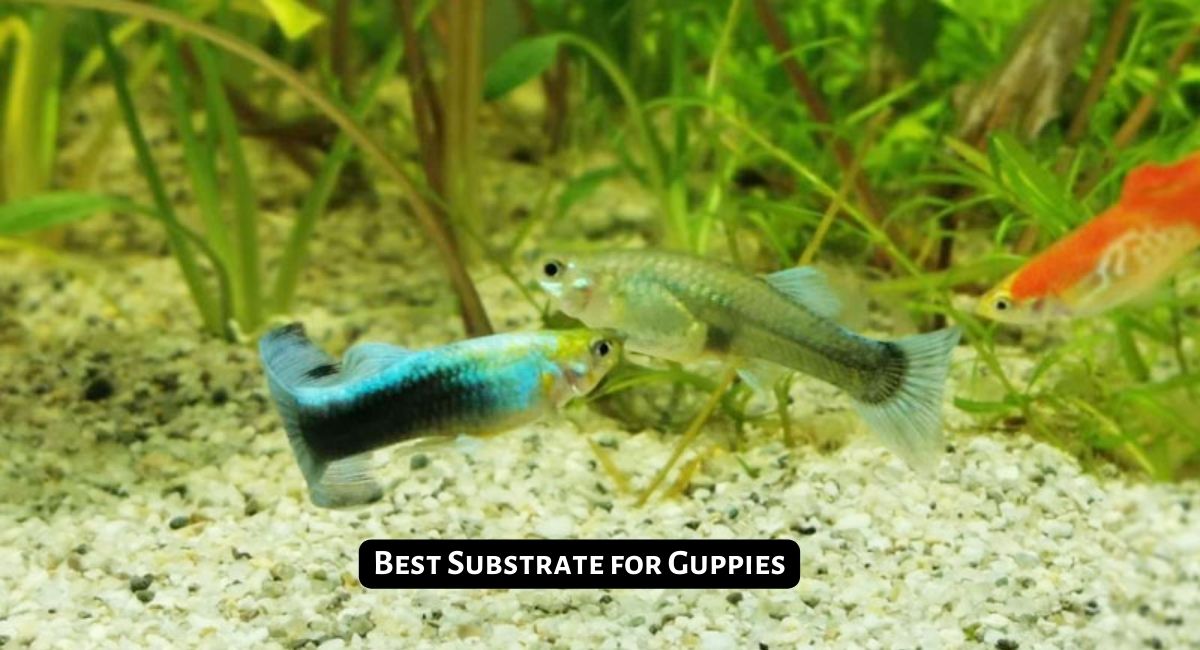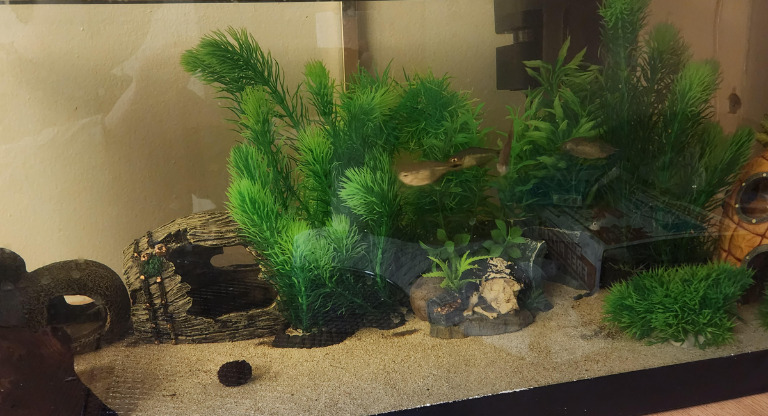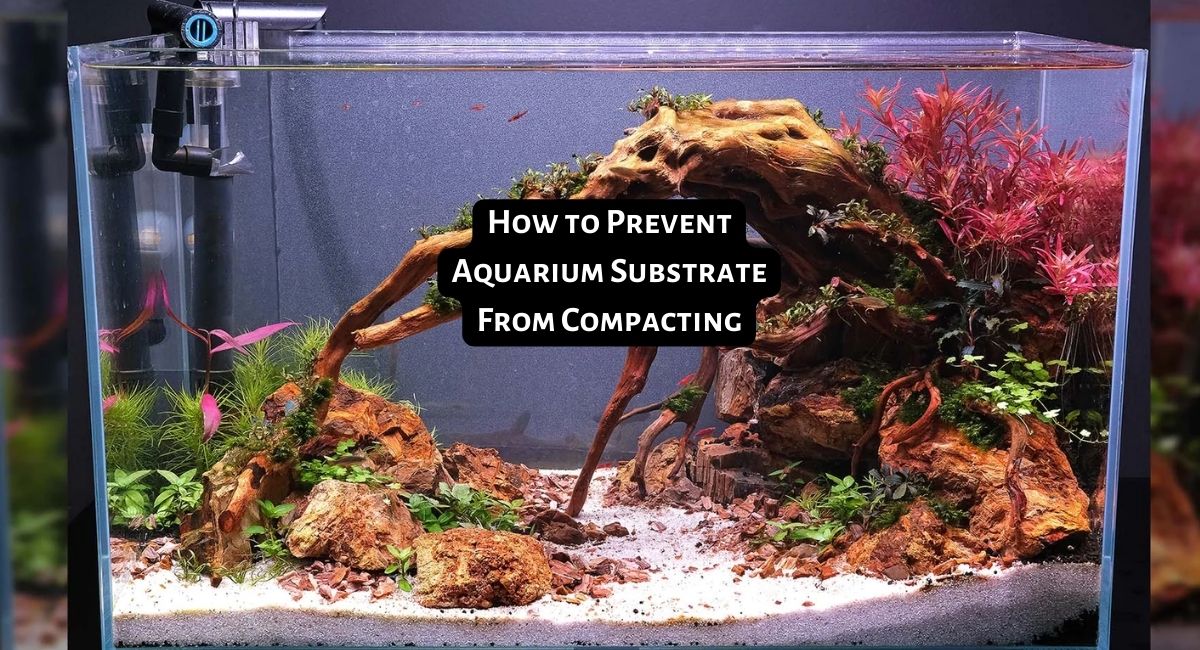Smartplantedaquarium.com participates in affiliate marketing programs. We may earn commissions on purchases made through our affiliate links. This doesn't affect our content or recommendations and we only recommend products we would put in our own tanks.
Choosing the best substrate for guppies is more than just an aesthetic decision; it directly impacts the health, behavior, and well-being of your fish. Substrates influence water chemistry, beneficial bacteria growth, and the overall environment of the aquarium.
As seasoned aquarists, we’ve spent years researching and testing various substrates, aiming to optimize the habitat for guppies. In this article, we’ll dive deep into the science and practicalities of choosing the best substrate for your guppies, ensuring a vibrant and thriving ecosystem for your friends.
Contents
Key Takeaways
- Guppies are a popular freshwater fish species in the aquarium hobby.
- The substrate choice for guppies can impact their health, behavior, and overall well-being.
- Substrates can mimic the natural environment, enhance aesthetics, house beneficial bacteria, support plant growth, and affect maintenance and behavioral considerations.
- The best substrates for guppies include fine gravel, sand, planted aquarium substrates, or a bare bottom setup.
- Substrates to avoid for guppies include sharp gravel or crushed glass, large gravel or rocks that pose a choking hazard, loose substrates that create cloudy water and clog filters, and crushed coral that raises pH and water hardness.
- Tips for choosing a substrate for guppies include considering size and texture, color, natural appearance, plant growth, pH and water hardness, ease of cleaning, substrate layers, inert vs. active substrate, budget, compatibility with tank mates, and personal aesthetics.
Do Guppies Need Substrate
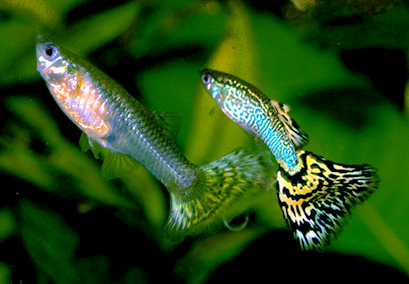
Guppies, like many other fish species, can thrive in aquariums both with and without substrate. However, the decision to include guppy substrate in an aquarium often depends on various factors such as aesthetics, maintenance, and the overall environment you wish to create for the fish. Here are some points to consider when deciding on the use of substrate for guppies:
- Natural Environment: In their natural habitat, guppies are found in a variety of water bodies, from clear streams to muddy ponds. A substrate can mimic this natural environment, providing a more familiar setting for the fish.
- Aesthetics: Substrate can enhance the visual appeal of an aquarium, giving it a more natural and vibrant look. It can complement the color of the guppies and make the aquarium more visually engaging.
- Beneficial Bacteria: A substrate can be a good home for beneficial bacteria, which play a vital role in the nitrogen cycle of the aquarium. These bacteria help break down fish waste, leftover food, and other organic matter.
- Plant Growth: If you plan to have live plants in your guppy tank, a substrate is essential. Many aquatic plants derive nutrients from the substrate and require it for root growth.
- Maintenance: Substrate can accumulate waste, which means you might need to clean it periodically. On the other hand, tanks without substrate can be easier to clean as debris is more visible and accessible.
- Behavioral Considerations: Some guppies might enjoy sifting through the substrate, which can be a form of enrichment for them.
Best Substrate for Guppies
When setting up an aquarium for guppies, choosing the right substrate can play a significant role in the overall health and well-being of the fish. A suitable substrate not only enhances the aesthetic appeal of the tank but also provides a conducive environment for the fish. Here’s a guide to the best substrates for guppies:
Fine Gravel
Using fine gravel as a substrate for guppies can be a suitable choice, but it’s essential to understand the advantages, considerations, and potential issues associated with it to ensure the health and well-being of your guppies. Here’s a closer look at using fine gravel for guppy aquariums:
Advantages:
- Versatility: Fine gravel comes in various colors and styles, allowing you to customize the look of your tank.
- Beneficial Bacteria: Its porous nature provides ample surface area for beneficial bacteria to colonize, aiding in biological filtration.
- Stability: Fine gravel creates a stable base for aquarium decorations and live plants.
Disadvantages:
- Weight: Fine gravel can be heavy, making it challenging to move the tank.
- Particle Ingestion: Guppies, being curious creatures, may accidentally ingest small gravel particles, which can lead to health issues.
Considerations:
- Cleaning: Fine gravel requires regular vacuuming to prevent the accumulation of waste and detritus between the particles.
- Smoothness: Ensure that the gravel is smooth with no sharp edges to prevent injuries to your guppies.
Sand
Using sand as a substrate for guppies in your aquarium can be a great choice, as it offers several advantages while also having some considerations and potential drawbacks. Here’s a detailed look at using sand for guppy tanks:
Advantages:
- Natural Look: Sand mimics the natural environment of many guppy species, enhancing the overall aesthetics of the tank.
- Plant Growth: It provides a stable foundation for the growth of aquatic plants, and many plant species thrive in sand.
- Behavior: Sand allows guppies to exhibit their natural sifting behavior, which they use to find food.
Disadvantages:
- Compaction: Sand can become compacted over time, inhibiting the growth of plant roots.
- Cloudiness: When introduced initially or disturbed, sand can cloud the water temporarily.
Considerations:
- Anaerobic Pockets: Over time, sand can develop anaerobic pockets that produce harmful gases. Stirring the sand occasionally can prevent this issue.
- Surface Waste: Like fine gravel, sand requires gentle vacuuming to remove surface waste and maintain water quality.
Planted Aquarium Substrates
Using planted aquarium substrates specifically designed for planted tanks can be an excellent choice for creating a thriving and visually appealing guppy aquarium. These substrates are formulated to provide essential nutrients for aquatic plants and offer several advantages, along with some considerations and potential disadvantages:
Advantages:
- Plant Health: Planted aquarium substrates are rich in essential nutrients, supporting the growth and health of aquatic plants.
- Aesthetics: They enhance the natural appearance of the tank, creating a lush and visually appealing underwater landscape.
Disadvantages:
- Depletion: Over time, the nutrients in these substrates can get depleted, requiring you to replenish them with fertilizers.
- Messiness: These substrates can be messy and easily disturbed by fish or water flow, potentially causing cloudiness or debris in the tank.
Considerations:
- Cost: Planted aquarium substrates are typically more expensive than other options, but they offer specific benefits for planted tanks.
- Water Parameters: Some planted substrates may alter pH or other water parameters, so it’s essential to monitor these changes.
Bare Bottom
Using a bare-bottom setup for a guppy aquarium has its own set of advantages and considerations, and it can be a suitable choice depending on your preferences and the goals for your tank. Here’s a detailed look at a bare-bottom setup for guppies:
Advantages:
- Easy Maintenance: Cleaning and maintenance become straightforward as there is no substrate to vacuum or disturb.
- Visibility: Waste and debris are immediately visible, making it easier to monitor and maintain water quality.
Considerations:
- Aesthetics: Some aquarists find bare bottom tanks less visually appealing, as they may appear less natural.
Disadvantages:
- Lack of Natural Behavior: Guppies cannot display behaviors like sifting through substrate, which is a natural behavior in their habitat.
- Reflection: The tank’s bottom can be reflective, potentially causing stress to the fish due to constant reflections.
Substrates to Avoid for Guppies
While substrates like sand and gravel make good choices, there are a few types of substrate that should be avoided for guppy tanks:
Sharp Gravel or Crushed Glass
Any substrate with sharp edges or points can damage guppies’ delicate fins and tails. Jagged gravel, crushed glass, and other irregularly shaped substrates should be avoided. Even substrates marketed as “aquarium gravel” can sometimes have sharper edges that can tear flowing fins. Opt for rounded, smooth gravel or sand grains to keep guppies safe.
Large Gravel or Rocks
Larger gravel substrates and rocks pose a risk because guppies could try to swallow them and choke. Adult guppies sometimes nibble at substrate, likely foraging for fallen food particles. But anything much bigger than the size of their mouth can obstruct their throat when swallowed. Stick to fine gravel under 5 mm diameter for guppy tanks.
Loose Substrates
Small lightweight particles like powdered coral and very fine sand can easily be sucked up into filters or stirred up during tank maintenance. This creates cloudy water and clogged filters, while also exposing guppies to debris and bacteria in the water column. Denser sands over 1 mm and gravel between 2-5 mm are less prone to such issues.
Crushed Coral
While marketed for aquariums, crushed coral is generally best avoided with guppies. The calcium carbonate particles dissolve over time and raise pH and water hardness. Such alkaline conditions can stress guppies, which prefer neutral to slightly acidic water. The substrate particles also pack down over time, allowing waste to accumulate on the bottom.
Tips for Choosing Substrate for Guppies
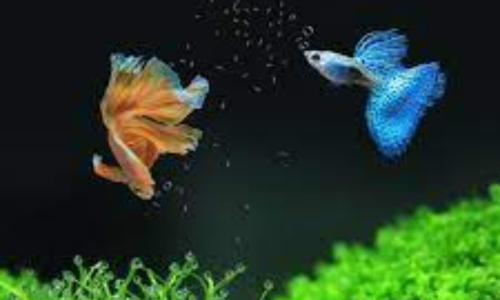
Choosing the right substrate for your guppy aquarium is important for creating a suitable environment that promotes their well-being and enhances the overall aesthetics of the tank. Here are some tips to consider when selecting a substrate for your guppies:
- Size and Texture: Guppies have delicate fins, making substrate texture crucial. Opt for fine sand (about 1-2 mm grain size) or smooth gravel to prevent fin damage. Rough substrates can lead to torn fins and stress in guppies.
- Color: Guppies come in various colors and patterns. Choosing a light-colored substrate, like beige or white sand, can make their vibrant hues stand out. Conversely, darker substrates, such as black gravel, can create a more natural and calming ambiance.
- Natural Appearance: Guppies are native to tropical habitats with abundant vegetation. Mimic their natural surroundings by using light-colored sand paired with live aquatic plants. This setup provides hiding spots and a comfortable environment.
- Plant Growth: Guppies benefit from live plants as they offer cover and improve water quality. Select a substrate rich in nutrients, like plant-specific substrates or soil-based ones, to promote robust plant growth.
- pH and Water Hardness: Guppies thrive in slightly alkaline to neutral pH levels (pH 6.8-7.8) and moderate water hardness (5-20 dGH). Choose a substrate that won’t drastically alter these parameters. Inert substrates like sand have minimal impact on water chemistry.
- Ease of Cleaning: Fine sand can be challenging to clean without getting siphoned out during water changes. To prevent this, hold the siphon just above the sand to avoid excessive removal.
- Substrate Layers: Consider a layered substrate approach. Place nutrient-rich substrate like plant-specific soil at the bottom, covered by a smoother top layer like fine sand. This aids plant root development while maintaining an attractive appearance.
- Inert vs. Active Substrate: Inert substrates like sand and smooth gravel have minimal impact on water chemistry. Active substrates like soil-based ones are beneficial for planted tanks but require careful monitoring of pH and ammonia levels.
- Budget: Substrate costs can vary widely. While specialized substrates may offer advantages, affordable options like pool filter sand or aquarium gravel can also work well for guppies.
- Compatibility with Tank Mates: If housing other species with guppies, select a substrate that suits all inhabitants. Some bottom-dwelling fish may require smoother substrates to prevent injuries.
- Aesthetics: The aesthetics of your aquarium are personal. Choose a substrate that aligns with your visual preferences, creating an environment that you find appealing and enjoyable.
What Do Guppies Like in Their Tank
Creating a comfortable and stimulating environment for guppies in your aquarium requires careful attention to various factors. Below is a detailed guide on how to provide the ideal conditions for these colorful and hardy fish.
By following these guidelines and providing your guppies with a well-maintained and suitable environment, you can ensure their health and happiness in your aquarium. Monitoring their behavior and water parameters regularly will help you address any issues promptly and enjoy the beauty of these colorful and lively fish.
Tank Decorations and Features
- Plants: Guppies thrive in aquariums with plenty of live plants. Species like Java moss, hornwort, and water wisteria not only enhance the tank’s aesthetics but also provide shelter, hiding spots, and surfaces for guppy fry to attach themselves to. Live plants also help improve water quality by absorbing nitrates, making the environment healthier for your fish.
- Caves and Hideouts: While guppies are generally active and social, they appreciate having places to retreat and hide, especially when they feel stressed or during breeding. Adding caves, PVC pipes, or small decorations with no sharp edges can provide these hiding spots.
- Swimming Space: Guppies are active swimmers, so ensure your tank has open areas where they can swim freely. Avoid overcrowding the tank with too many decorations, which can limit their swimming space.
Water Quality and Parameters
- Temperature: Maintain the water temperature between 74°F to 82°F (23°C to 28°C). Guppies are sensitive to temperature fluctuations, so invest in a reliable heater to keep the water stable.
- pH Level: Guppies thrive in slightly acidic to slightly alkaline water, with a pH range of 6.8 to 7.8.
- Water Hardness: Guppies prefer moderate water hardness, typically between 8-12 degrees of General Hardness (dGH).
- Ammonia, Nitrite, and Nitrate: Ensure ammonia and nitrite levels are consistently at zero, as these compounds are toxic to fish. Keep nitrates as low as possible, ideally below 20 ppm, through regular water changes and proper filtration.
Tank Mates
- Compatibility: Guppies are generally peaceful and can be kept with other non-aggressive fish of similar size. Suitable tank mates include tetras (e.g., Neon Tetras), Corydoras catfish, small rasboras, mollies, and platies. Avoid keeping guppies with fin-nipping or much larger, aggressive fish that may harass them.
Diet and Feeding
- Balanced Diet: Guppies are omnivores, so offer a balanced diet to maintain their vibrant colors and overall health. High-quality flake or pellet food is the primary staple.
- Variety: Supplement their diet with occasional treats like live or frozen foods such as brine shrimp, daphnia, and bloodworms to provide essential nutrients and stimulation.
- Feeding Frequency: Feed your guppies in small amounts once or twice a day. Ensure they consume all the food within a few minutes to prevent overfeeding, which can lead to water contamination.
Lighting
- Standard Lighting: Guppies don’t have specific lighting requirements. A standard aquarium light with a photoperiod of 8-10 hours a day helps simulate a natural day-night cycle and showcases their vibrant colors.
Filtration and Aeration
- Quality Filtration: Invest in a good-quality filter to maintain clean water and remove toxins. A filter with biological, mechanical, and chemical filtration capabilities is ideal.
- Aeration: Gentle water movement from the filter provides adequate oxygenation. However, guppies don’t appreciate strong currents, so avoid overly powerful filters or air stones that create strong turbulence.
Conclusion
Choosing the best substrate for your guppy aquarium is an important decision that can impact the health and well-being of your fish and plants. After considering the options, it’s clear that there are several good choices available, each with its own advantages and disadvantages.
Sand, gravel, aquasoil, and coir fiber are all great options for guppy tanks, but it ultimately comes down to personal preference, budget, and the specific needs of your aquarium. For a natural and eco-friendly option, coir fiber can be a good choice. For a planted tank, aquasoil is a great substrate that provides nutrients to plants. Sand and gravel are also great options, providing a natural look and easy maintenance.
Regardless of which substrate you choose, it’s important to properly clean it before adding it to the aquarium and to regularly maintain the tank to ensure a healthy environment for your guppies. With the right substrate and care, your guppies and plants will thrive and create a beautiful underwater world in your home.
Frequently Asked Questions
1. How often should the substrate be cleaned in a guppy tank?
The substrate in a guppy tank should be cleaned every two to four weeks. This frequency ensures that waste and leftover food are removed, maintaining a healthy environment for the guppies. However, if you notice visible debris or detritus accumulating faster, consider cleaning more frequently.
2. What do you put at the bottom of a guppy tank?
For guppy tanks, the bottom typically consists of a substrate. Common choices include fine-grained aquarium sand or small-sized gravel. Some aquarists also use specialized planted tank substrates if they plan to have live plants. The chosen substrate not only adds aesthetic appeal but also provides a medium for beneficial bacteria to thrive.
3. Do guppies prefer flakes or pellets?
Guppies generally prefer flakes over pellets due to their small mouth size. Flakes are easier for them to consume and digest. However, some guppies can be acclimated to fine pellets. It’s essential to ensure that any food provided is appropriately sized for guppies to prevent choking or digestive issues.
4. What is the ideal depth of substrate in a guppy tank?
The ideal depth of substrate in a guppy tank is between 1 to 2 inches (2.5 to 5 cm). This depth allows for adequate root growth if you have live plants and provides sufficient space for beneficial bacteria to colonize.
5. What makes guppies happy?
Guppies are happiest in a well-maintained tank with stable water conditions, adequate space to swim, and a mix of hiding places and open areas. They appreciate live plants, which offer shelter and foraging opportunities. A varied diet, including high-quality flakes and occasional live or frozen foods, also contributes to their well-being. Finally, keeping them in social groups and ensuring they have compatible tankmates enhances their overall happiness.
6. Do Guppies Prefer Sand or Gravel?
Guppies tend to favor sand substrate because it’s softer and more comfortable for them to swim in and find food. Moreover, sand is less prone to trapping debris and waste, reducing potential water quality issues.
